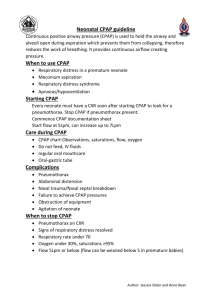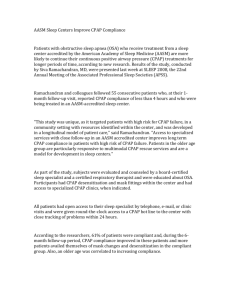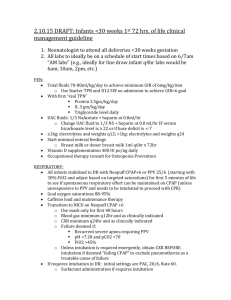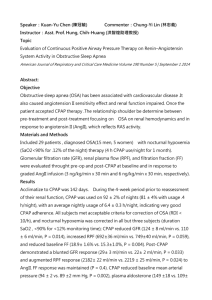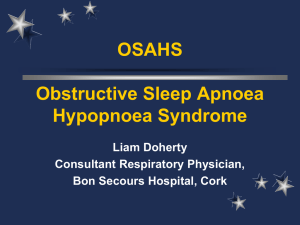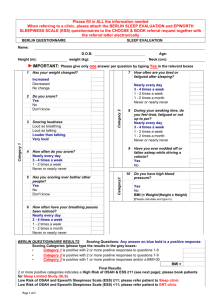ONLINE SUPPLEMENT Predictors of residual sleepiness in adequately treated obstructive
advertisement
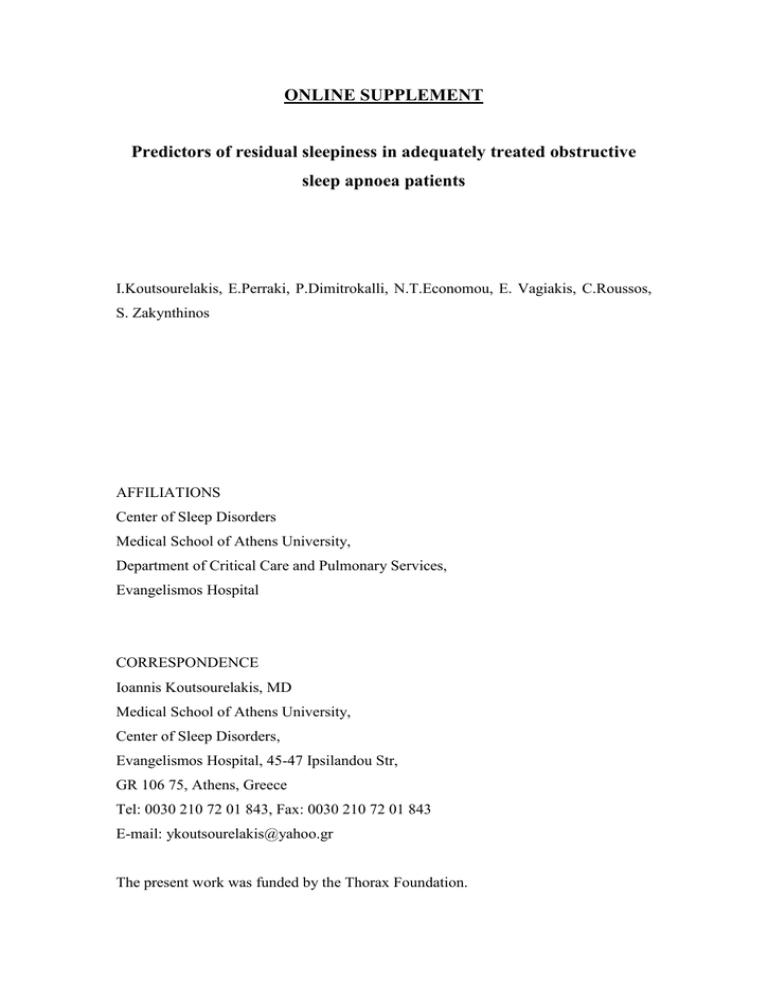
ONLINE SUPPLEMENT Predictors of residual sleepiness in adequately treated obstructive sleep apnoea patients I.Koutsourelakis, E.Perraki, P.Dimitrokalli, N.T.Economou, E. Vagiakis, C.Roussos, S. Zakynthinos AFFILIATIONS Center of Sleep Disorders Medical School of Athens University, Department of Critical Care and Pulmonary Services, Evangelismos Hospital CORRESPONDENCE Ioannis Koutsourelakis, MD Medical School of Athens University, Center of Sleep Disorders, Evangelismos Hospital, 45-47 Ipsilandou Str, GR 106 75, Athens, Greece Tel: 0030 210 72 01 843, Fax: 0030 210 72 01 843 E-mail: ykoutsourelakis@yahoo.gr The present work was funded by the Thorax Foundation. Table 1S. Demographic, clinical and polysomnographic features of the OSAS patients with excessive daytime sleepiness (ESS score > 10) determined at baseline assessment. Patients who exhibited after CPAP treatment (mean daily use ≥ 5 hours during follow-up period) normal ESS score (< 11) were defined as CPAP responders, whereas those who exhibited after CPAP treatment abnormal ESS score (> 10) thus demonstrating residual excessive daytime sleepiness were defined as CPAP nonresponders. CPAP responders CPAP non-repsonders n=89 n=36 Age (years) 50.7±12.5 61.4±10.8** Body mass index (kg∙m-2) 33.9±7.1 32.8±7.3 86.5 69.4# Respiratory disturbance index 58.9±34.2 40.5±26.6* ESS score 14.0±3.0 16.1±3.4* 5.6 30.6** 0 50.0** Hypothyroidism (%) 5.6 11.1 Alcohol use (%) 16.9 11.1 Heart disease (%) 39.3 63.9# COPD (%) 7.9 25.0* Stroke (%) 12.4 11.1 Smoke (%) 40.4 47.2 REM/TST (%) 11.8±7.8 10.5±7.4 S1/TST (%) 5.5±6.3 5.6±5.3 S2/TST (%) 80.0±14.7 75.8±18.6 SWS/TST (%) 2.5±8.8 7.2±16.7 Average oxygen saturation (%) 89.6±5.9 90.5±5.0# Lowest oxygen saturation (%) 71.6±10.7 74.0±11.4 Male (%) Diabetes (%) Depression (%) Continuous data are presented as mean ± SD. #: p<0.05 versus CPAP responders; *: p<0.01 versus CPAP responders;**: p<0.001 versus CPAP responders. ESS: Epworth sleepiness scale; COPD: chronic obstructive pulmonary disease; TST: total sleep time; REM: rapid eye movement sleep; SWS: slow wave sleep. Table 2S. Demographic, clinical and polysomnographic features of the OSAS patients with excessive daytime sleepiness (ESS score > 10) determined at baseline assessment. Patients who exhibited after CPAP treatment (mean daily use ≥ 6 hours during follow-up period) normal ESS score (< 11) were defined as CPAP responders, whereas those who exhibited after CPAP treatment abnormal ESS score (> 10) thus demonstrating residual excessive daytime sleepiness were defined as CPAP nonresponders. CPAP responders CPAP non-repsonders n=69 n=25 Age (years) 48.5±11.4 60.7±11.4** Body mass index (kg∙m-2) 34.2±7.1 32.4±8.2 88.4 68.0# 61.2 ±34.7 33.2±24.0** 14.0±3.2 15.3±3.1 7.2 28.0* 0 60.0** Hypothyroidism (%) 7.2 12.0 Alcohol use (%) 17.4 12.0 Heart disease (%) 40.6 64.0# COPD (%) 4.3 20.0* Stroke (%) 5.8 8.0 Smoke (%) 43.5 52.0 REM/TST (%) 11.5±7.8 11.8±7.3 S1/TST (%) 6.0±6.9 5.5±5.8 S2/TST (%) 79.3±15.9 73.3±16.7 SWS/TST (%) 3.2±9.9 7.8±15.8 Average oxygen saturation (%) 89.3±6.3 91.9±3.6 Lowest oxygen saturation (%) 71.5±10.9 77.7±9.3# Male (%) Respiratory disturbance index ESS score Diabetes (%) Depression (%) Continuous data are presented as mean ± SD. #: p<0.05 versus CPAP responders; *: p<0.01 versus CPAP responders;**: p<0.001 versus CPAP responders. ESS: Epworth sleepiness scale; COPD: chronic obstructive pulmonary disease; TST: total sleep time; REM: rapid eye movement sleep; SWS: slow wave sleep. Table 3S. Univariate and multivariate predictors of residual excessive daytime sleepiness after CPAP therapy. UNIVARIATE ANALYSIS MULTIVARIATE ANALYSIS Cutoff 4 hours per day OR (95% CI) p OR (95% CI) p 10.66 (4.31-26.41) <0.001 6.87 (2.50-18.91) <0.001 Heart disease (0 = no, 1 = yes) 3.07 (1.74-5.41) <0.001 2.94 (1.41-6.15) 0.004 Epworth sleepiness scale score 1.28 (1.15-1.42) <0.001 1.31 (1.15-1.49) <0.001 Respiratory disturbance index 0.98 (0.97-0.99) 0.001 0.97 (0.96-0.98) <0.001 OR (95% CI) p OR (95% CI) p Diabetes (0 = no, 1 = yes) 7.39 (2.34-23.28) 0.001 5.83 (1.59-21.33) 0.008 Heart disease (0 = no, 1 = yes) 2.73 (1.22-6.10) 0.014 1.77 (0.70-4.50) 0.229 Epworth sleepiness scale score 1.21 (1.07-1.36) 0.002 1.30 (1.12-1.52) 0.001 Respiratory disturbance index 0.98 (0.97-0.99) 0.006 0.97 (0.96-0.99) 0.002 OR (95% CI) p OR (95% CI) p Diabetes (0 = no, 1 = yes) 4.98 (1.41-17.57) 0.013 4.22 (0.98-18.13) 0.053 Heart disease (0 = no, 1 = yes) 2.60 (1.01-6.71) 0.048 1.38 (0.46-4.13) 0.561 Epworth sleepiness scale score 1.13 (0.98-1.30) 0.082 1.22 (1.02-1.45) 0.032 Respiratory disturbance index 0.97 (0.95-0.99) 0.001 0.97 (0.95-0.99) 0.001 Diabetes (0 = no, 1 = yes) Cutoff 5 hours per day Cutoff 6 hours per day Cutoff values of 4, 5 and 6 hours per day correspond to definition of good compliance as mean daily CPAP use ≥ 4, ≥ 5 and ≥ 6 hours during follow-up, respectively, and of poor compliance as mean daily CPAP use < 4, < 5 and < 6 hours during follow-up, respectively. With cutoff 4 hours per day, the cohort included 208 patients, 94 CPAP responders (45%) and 114 CPAP non-responders (55%). With cutoff 5 hours per day, the resulting cohort included 125 patients, 89 CPAP responders (71%) and 36 CPAP non-responders (29%). With cutoff 6 hours per day, the resulting cohort included 94 patients, 69 CPAP responders (73%) and 25 CPAP non-responders (27%). Univariate logistic regression analysis was performed in order to determine the contribution of each variable to residual excessive daytime sleepiness after CPAP therapy without adjusting for other covariates. Multivariate logistic regression analysis was performed in order to identify the variables that were independently associated with residual excessive daytime sleepiness after CPAP therapy. All variables were determined at baseline assessment. Depression was not included in the analyses because it offered a near complete separation between CPAP responders and CPAP non-responders and maximum likelihood estimation was not achieved. Among patients, the odds of having residual excessive daytime sleepiness after CPAP therapy increased with the presence of diabetes, heart disease, and higher Epworth sleepiness scale score and lower respiratory disturbance index at baseline assessment. OR: Odds ratio; CI: Confidence intervals.
